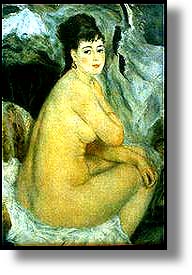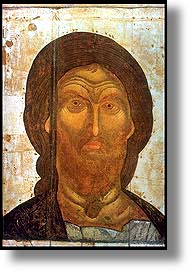 Fine
Art in Moscow
Fine
Art in Moscow | Exploring Moscow | |
| Moscow's Kremlin | |
| Moscow's Red Square | |
| Fine Arts & Museums | |
| Theatres of Moscow | |
| Old Moscow | |
| Mementos of the Soviet | |
| Moscow Accommodations |
Original Official Site of the Russian National Tourist Office
The Pushkin Fine Arts Museum
 Opened
in 1912, the Pushkin Fine Arts Museum possesses a collection of European
art second in Russia to only St. Petersburg's Hermitage. Much of
the strength of the collection is in Impressionist and Post-Impressionist
painting, a result of the oft-forgotten fact that such works gained
an appreciative audience in Russia long before they captured the
imagination of collectors further west. Manet's Dejeuner sur l'herbe
resides here, as do Renoir's Bathing in the Seine, a host of fine
works by Van Gogh and Matisse, and an entire gallery of Gauguins.
Perhaps most exciting, however, is the long-anticipated "Gold
of Troy" exhibition, slated for April 1996.
Opened
in 1912, the Pushkin Fine Arts Museum possesses a collection of European
art second in Russia to only St. Petersburg's Hermitage. Much of
the strength of the collection is in Impressionist and Post-Impressionist
painting, a result of the oft-forgotten fact that such works gained
an appreciative audience in Russia long before they captured the
imagination of collectors further west. Manet's Dejeuner sur l'herbe
resides here, as do Renoir's Bathing in the Seine, a host of fine
works by Van Gogh and Matisse, and an entire gallery of Gauguins.
Perhaps most exciting, however, is the long-anticipated "Gold
of Troy" exhibition, slated for April 1996.
The Tretyakov Gallery
 The
Tretyakov Gallery possesses the finest collection of traditional
Russian painting in the world. The core of the museum's collection
was assembled in the middle of the nineteenth century by Pavel Tretyakov,
a wealthy Moscow merchant whose passion for collecting included violins,
birds, and milk cows as well as Russian art. Tretyakov donated his
extensive collection to the city in 1892, and subsequent enlargement
has long since provided the Gallery with far more works than it can
possibly exhibit in its limited space. Although this means that innumerable
fine works rarely see the light of day, it also means that those
works that are displayed are without exception masterpieces of their
period and genre. While everything in the Tretyakov deserves and
rewards patient attention, its collection of icons stands as the
definitive presentation of this most Russian of art forms.
The
Tretyakov Gallery possesses the finest collection of traditional
Russian painting in the world. The core of the museum's collection
was assembled in the middle of the nineteenth century by Pavel Tretyakov,
a wealthy Moscow merchant whose passion for collecting included violins,
birds, and milk cows as well as Russian art. Tretyakov donated his
extensive collection to the city in 1892, and subsequent enlargement
has long since provided the Gallery with far more works than it can
possibly exhibit in its limited space. Although this means that innumerable
fine works rarely see the light of day, it also means that those
works that are displayed are without exception masterpieces of their
period and genre. While everything in the Tretyakov deserves and
rewards patient attention, its collection of icons stands as the
definitive presentation of this most Russian of art forms.
Gorky House Museum
One of Moscow's finest examples of the art nouveau architecture of Fyodor Shekhtel, also known as the Ryabushinsky Mansion. The building served as the residence of the great writer Maxim Gorky from 1931 to 1936. Built just after the turn of this century, the mansion is appealing for its remarkable design and decoration, both inside and out. Shekhtel's design is an almost hallucinatory masterpiece of wave forms, floral mosiac and stucco decorations, and vibrant hues--the uncontested highlight is the sinuous main stair. All of this contrasts strongly with the building's significance as the home of one of Russia's greatest "proletarian" writers, but the irony merely adds interest to a visit.







